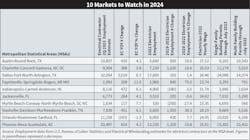10 Local Markets to Watch in 2024
When evaluating your local market’s growth prospects, you can use some pretty simple economic indicators to gauge where business may be headed in the near future. You can’t go too far wrong by first looking at one key filter: Comparing your local county, Metropolitan Statistical Areas (MSAs), or state with the national growth rate for these key indicators:
- Population growth from 2017 to 2022 and from 2021 to 2022
- Electrical contractor and/or electrician employment
- Single-family and multi-family building permits
- Construction projects in the planning process or getting ready to break ground
The fastest-growing local markets are usually cranking along at double the national rate of growth (or their state’s rate of growth) for population, electrical contractor or electrician employment, and building permits. The Table below shows our picks for the 10 MSAs that will offer solid growth potential in 2024. We chose a mix of large, medium, and small markets to give you a sense of the growth opportunities in metropolitan areas of various sizes. It’s tough to limit our picks to just 10 markets, and we could have easily added the Atlanta and Seattle metros as well because they continue to grow at an impressive rate. Ditto for the fast-growing MSAs along Florida’s Gulf Coast, which year-after-year (YOY) see double-digit population growth to fuel demand for new vacation homes, senior housing, and single-family homes for new residents from colder climates. Unfortunately, some of the growth of these markets over the past year must be attributed to reconstruction efforts from last fall’s Hurricane Ian. Industrially oriented electrical contractors may also want to compare their local markets with some of the areas seeing a surge of business from the new electric vehicle factories, EV battery plants, or semiconductor fabrication facilities now being built. Arizona, Georgia, Kansas, Kentucky, Michigan, Ohio, and Tennessee are just a few of the states cashing in on these new projects.
This article will give you some ideas on where you can find data on your local market for electrician or electrical contractor employment; population growth; building permits; or new construction projects. Much of it is available for free from the U.S. Bureau of Labor Statistics (www.bls.gov) or the U.S. Census Bureau (www.census.gov). Electrical Marketing, EC&M’s sister publication, also provides local employment, building permit, and population data, as well as a quarterly update on construction projects of more than $100 million in total contract value as part of a $99 annual membership (www.electricalmarketing.com).
Employment data
The U.S. Bureau of Labor Statistics provides construction employment data at the county, MSA, state, and national level and electrician data at the MSA, state, and national level. The trick is that the data comes out in different release cycles, and you have to massage the local construction employment data to get an estimate for electrical contractor employment.
Electricians. BLS releases electrician data for the previous year annually. The 2022 electrician employment data (tabulated for May 2022) was released in April 2023 at www.bls.gov/oes/tables.htm. Included in this data is information on mean hourly and mean annual wages.
Electrical contractors. The U.S. Census Bureau releases national electrical contractor employment data each month at https://www.bls.gov/ces/, but it does not break out its electrical contractor data by state, county, or MSA. However, you can use the total construction employment data published each month at www.bls.gov/sae for MSAs and states and www.bls.gov/cew each quarter for counties, and then multiply it by 13% to get a realistic estimate for the contractor count in those markets. EC&M’s editors have compared the national electrical contractor data to the national construction data going back to 2000 and have found that it’s almost always 13% of the total. While local markets do vary, this multiplier will give you a good starting point. If you are working with the monthly data, it’s a good idea to use an average for the current month and the preceding two months to smooth out some of the volatility in the data. It’s frustrating that the county data published in the Census Dept.’s Quarterly Census of Employment and Wages report is always at least six months old, but it’s the best available source of data for this geography.
Population growth
Why the interest in population growth? There’s a direct correlation between the number of new residents moving into (or leaving) a market area and the level of residential construction activity, which in turn feeds the construction of strip shopping centers and other retail areas, new schools and hospitals, and other commercial and institutional construction. You can use annual and historical population data at the state, MSA, and county level from the U.S. Census Bureau to measure a geographic area’s growth.
Population data can help you develop two other interesting local growth indicators — the number of residents moving into or out of a local area each day and the number of building permits per 1,000 residents. Tabulating the new residents per day in a local market is a quick and easy indicator that gives you a sense of just how fast a market is growing (or shrinking, if the population is declining, and more people are moving out of an area than moving into it).
The U.S. Census Department releases population data at the county, MSA, state, and national level annually at www.census.gov/data/datasets/time-series/demo/popest/2020s-total-metro-and-micro-statistical-areas.html. County data is available at www.census.gov/data/datasets/time-series/demo/popest/2020s-counties-total.html.
Building permits
The U.S. Census Bureau publishes monthly building permit data at the national, MSA, and state level at www.census.gov/construction/bps/msamonthly.html, and you can always find interesting commentary on residential construction trends at www.nahb.org. Calculating the number of building permits/per thousand residents gives you a way to compare large and small markets with each other because you have a common denominator.
By this measure, some fairly small MSAs are ranked among the fastest-growing MSAs, including the vacation/ retirement hot spot Myrtle Beach-Conway-North Myrtle Beach, S.C.-N.C. MSA with 12.5 single-family permits per 1,000 residents.
Construction project data
The two biggest providers of data on local construction projects in the pipeline are the Dodge Construction Network (www.construction.com) and ConstructConnect (www.constructconnect.com). This information is available on a subscription basis. As mentioned earlier, www.electricalmarketing.com also provides quarterly updates on construction projects with a total construction value of more than $100 million as part of a $99 annual membership.
Summary
You can use the tools described in this article to analyze the growth potential of a local market and compare it to other markets in your state or at the national level. If you have questions on any of the data sources or tabulation methods discussed in this article, please email [email protected].

